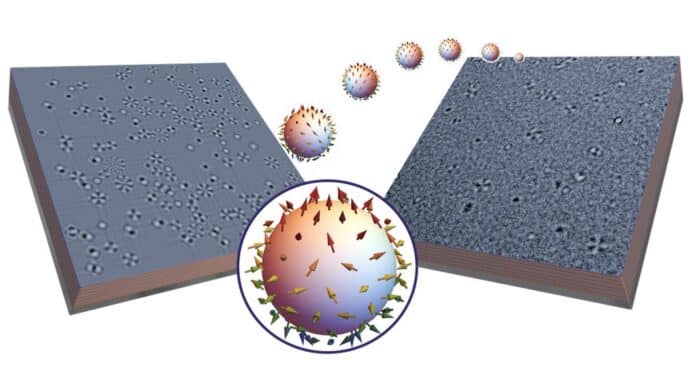Magnetic skyrmions are stable, localized, and topological magnetic textures that can be manipulated like ordinary particles when subjected to external stimuli. The control of spin textures using spin-polarized currents has enabled the development of skyrmionic devices, including racetrack memory and neuromorphic or reservoir computing. The coexistence of skyrmions with high topological charge in a single system holds potential for diverse and efficient technological applications.
Researchers from the University of Augsburg and the University of Vienna have identified the coexistence of magnetic skyrmions and antiskyrmions with arbitrary topological charge at room temperature in magnetic Co/Ni multilayer thin films. This discovery marks a breakthrough in skyrmionics research. Identifying novel spin objects with arbitrary topological charge holds promise for advancements in fundamental and applied research, especially in the development of information storage devices.
The researchers demonstrated that these spin objects can only be found in a specific phase pocket within the stability diagram where the quality factor Q has a value of about 1, determined by the ratio between the uniaxial magnetic anisotropy and the magnetic shape anisotropy.
Extensive simulations, led by Sabri Koraltan and the simulation group at the University of Vienna, along with support from Dr. Nikolai Kiselev from Forschungszentrum Jülich, helped identify the reasons for the presence of spin objects in the stability diagram, their formation process, and the required material properties. This knowledge can be applied to other material systems.
Prof. Manfred Albrecht said, “We are very enthusiastic about the exciting insights gained by discovering these spin objects, which can be easily fabricated at room temperature. This is an outstanding scientific advance in the field of skyrmions and topological spin objects. These nanoscale skyrmionic spin textures provide extra degrees of freedom and can be embedded in thin-film devices enabling different applications ranging from unconventional computing to new storage concepts.”
Sabri Koraltan at the University of Vienna said, “A further very essential aspect of spin objects is that a spin-polarised current induces their motion. When a charge current passes through a conducting magnetic material, the polarised electron spin will exert a torque on the magnetization known as the spin-transfer-torque.”
“This torque can set the higher order skyrmions in motion. Using micromagnetic simulations we could demonstrate the efficient control of the motion of these extraordinary spin objects, which opens up further opportunities for skyrmionic devices.”
Mariam Hassan, a postdoctoral researcher at the University of Augsburg said, “To what extent our predictions about their motion characteristics can be confirmed experimentally will be very exciting to research in the near future.”
Journal Reference:
- M. Hassan, S. Koraltan, A. Ullrich, F. Bruckner, R.O. Serha, K.V. Levchenko, G. Varvaro, N.S. Kiselev, M. Heigl, C. Abert, D. Suess, and M. Albrecht: “Dipolar skyrmions and antiskyrmions of arbitrary topological charge at room temperature”, Nature Physics. DOI: 10.1038/s41567-023-02358-z
